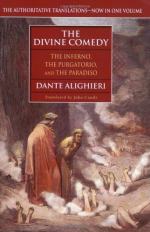|
This section contains 5,593 words (approx. 19 pages at 300 words per page) |

|
SOURCE: “Shadows on the Mount of Purgatory,” Dante Studies, Vol. XCVII, 1979: pp. 47-63.
In the following essay, Berk explains the significance of the Pilgrim's shadow, and examines Dante's poetic techniques in utilizing the shadow motif.
The question of precedence is a difficult matter to establish or settle, but it may be that Dante, in the repeated dramatic use of the pilgrim's cast shadow in the Purgatorio, was the first artist of magnitude in painting as well as in literature to represent the phenomenon of cast shadows since antiquity. Art historians appear to be in disagreement about dating the first cast shadows in the pictorial arts. Erwin Panofsky holds that it was the Brothers Limbourg in the first years of the fifteenth century who rediscovered cast shadows, while Frederick Hartt observes: “With very few exceptions, cast shadows do not appear in painting until the Quattrocento, yet we can hardly...
|
This section contains 5,593 words (approx. 19 pages at 300 words per page) |

|


